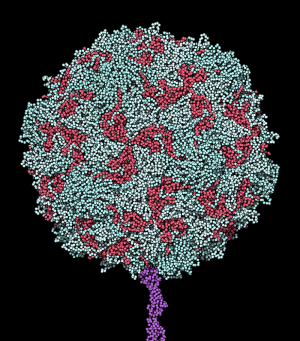August 19, 2014 report
Mutant poliovirus caused Republic of Congo outbreak in 2010

(Medical Xpress)—In 2010, a polio outbreak in the Republic of Congo (ROC) resulted in 445 confirmed cases, of which 47% were fatal. Originally, researchers thought low levels of immunization were responsible for the severity of the outbreak. However, Christian Drosten of the University of Bonn Medical Center and colleagues have discovered that a vaccine-resistant mutation of poliovirus caused the outbreak in ROC. The research appears in the Proceedings of the National Academy of Sciences.
Since the World Health Organization's Global Polio Eradication Initiative was passed in 1988, the number of countries in which poliomyelitis is endemic has decreased from 125 to 3 - Nigeria, Afghanistan and Pakistan. However, in recent years, there have been outbreaks in nonendemic countries, including ROC, Tajikistan and China. The ROC outbreak, which centered around the city of Pointe Noire, was exceptional because of its high fatality rate. In addition, it affected an unusually large number of adults. The median age of patients who developed acute flaccid paralysis (AFP) was 20. In comparison, during a 2010 outbreak in Tajikistan, 44 percent of AFP cases involved children under five. The fatality rate during that outbreak was only six percent.
Previous researchers attributed the severity of the ROC outbreak to low levels of vaccination in adults. However, further investigation showed that many adult patients had received oral polio vaccine.
To understand why the vaccine had not protected these patients, Drosten's team sequenced the virus involved in the outbreak. They found it had two mutations that made it difficult for antibodies to stick to it. The closest relative of the ROC virus was an Angolan strain isolated in 2009, which had one of the mutations. Both of these strains descended from a strain that originated in Asia, where the virus is still endemic in some places.
When the researchers tested the virus on blood from Gabonese volunteers, German outpatients and German medical students already vaccinated against polio, they found that antibodies in the blood were less effectiveness against the ROC strain than against the strain used to make the vaccine. Between 15 and 29 percent of the students would have had no protection against the ROC virus.
Drosten's team found that unhygienic conditions, including overcrowding and the use of covered well water, could have exacerbated the spread of the disease in ROC. The researchers warn that the ability of poliomyelitis to mutate means that populations with robust immunity to an older version of the virus could become victims of new outbreaks. Continued revaccination and surveillance of environmental conditions would prevent more outbreaks from occurring.
More information: Robustness against serum neutralization of a poliovirus type 1 from a lethal epidemic of poliomyelitis in the Republic of Congo in 2010 , Jan Felix Drexler, PNAS, DOI: 10.1073/pnas.1323502111
Abstract
In 2010, a large outbreak of poliomyelitis with unusual 47% lethality occurred in Pointe Noire, Republic of Congo. Vaccine-mediated immunity against the outbreak virus was never investigated. A wild poliovirus 1 (WPV1) isolated from a fatal case (termed PV1-RC2010) showed a previously unknown combination of amino acid exchanges in critical antigenic site 2 (AgS2, VP1 capsid protein positions 221SAAL→221PADL). These exchanges were also detected in an additional 11 WPV1 strains from fatal cases. PV1-RC2010 escaped neutralization by three different mAbs relevant for AgS2. Virus neutralization was tested in sera from fatal cases, who died before supplementary immunization (n = 24), Gabonese recipients of recent oral polio vaccination (n = 12), routinely vaccinated German medical students (n = 34), and German outpatients tested for antipoliovirus immunity (n = 17) on Vero, human rhabdomyosarcoma, and human epidermoid carcinoma 2 cells. Fatal poliomyelitis cases gave laboratory evidence of previous trivalent vaccination. Neutralizing antibody titers against PV1-RC2010 were significantly lower than those against the vaccine strain Sabin-1, two genetically distinct WPV1s isolated in 1965 and 2010 and two genetically distinct vaccine-derived PV strains. Of German vaccinees tested according to World Health Organization protocols, 15–29% were unprotected according to their neutralization titers (<1:8 serum dilution), even though all were protected against Sabin-1. Phylogenetic analysis of the WPV1 outbreak strains suggested a recent introduction of virus progenitors from Asia with formation of separate Angolan and Congolese lineages. Only the latter carried both critical AgS2 mutations. Antigenetically variant PVs may become relevant during the final phase of poliomyelitis eradication in populations with predominantly vaccine-derived immunity. Sustained vaccination coverage and clinical and environmental surveillance will be necessary.
© 2014 Medical Xpress

















